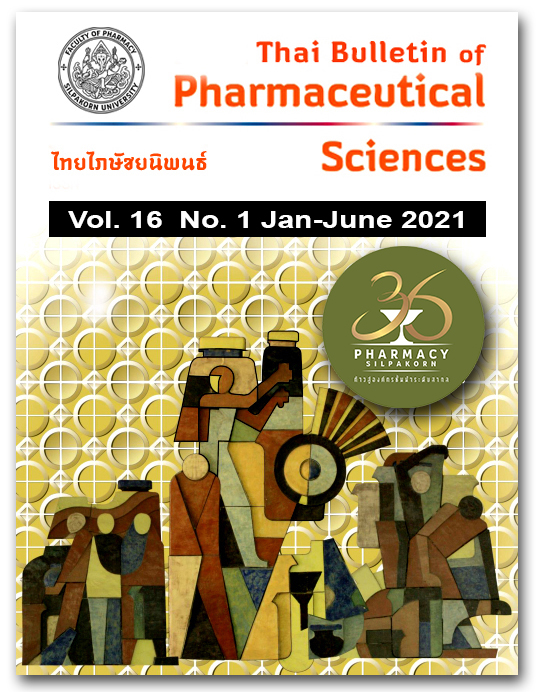DEVELOPMENT AND EFFECTIVENESS STUDY OF PREVENTABLE SYSTEM FOR DRUG INDUCED ADVERSE DRUG EVENTS IN PATIENTS RECEIVING ANTIRETROVIRAL MEDICINE AT DAYCARE CLINIC, NAN HOSPITAL
DOI:
https://doi.org/10.69598/tbps.16.1.1-15Keywords:
drug interaction, anti-retroviral agents, adverse drug eventsAbstract
This study utilized mixed methods research which was divided into 3 phases. The first phase was a cross-sectional descriptive study primarily aimed to examine the prevalence of drug interaction in patients receiving antiretroviral agents. The second phase was an action research study with the purpose to develop a system in preventing adverse events from these interactions of patients taking antiretroviral agents. Lastly, another cross-sectional descriptive study was applied to assess the effects of the prevention system of adverse drug events from the drug interaction of patients receiving antiretroviral agents. The results from Phase 1 revealed that the prevalence of drug interaction in patients receiving anti-retroviral agents between May 2018 and January 2019 garnered thirty percent (30%). The analysis of data for Phase 2 applied the principles of the Pareto diagram. The focus group included seven (7) medical personnel and two (2) leaders of infected people in the Nan Province. It further revealed that the group discussion team jointly developed a follow-up system for patients receiving efavirenz-amlodipine and efavirenz-simvastatin for the first time. Furthermore, it set the tracking period to be less than 1 month and established a system to prevent the use of NSAIDs in patients taking tenofovir called “patient with contraindications of the medicine” system. After the development of the system, the data collection for Phase 3 was undertaken. Hence, the prevalence of drug interaction in this study has been reduced to twenty-one percent (21%) from the pre-development period by thirty-one percent (31%). As this study attempted to uncover the development and effectiveness of a preventable system, it showed that the medical team could follow up with patients faster, allow immediate solutions to problems caused by interactions and create a system to prevent drug-drug interaction. Thus, the results of this research guarantee patient safety.
References
Tragulpiankit P. Overlapping paradigms between drug interactions and adverse drug reactions. In: Chindavijak B, Jurawattanaton S, Suansanae T, Suwannoi L, Wichitnaowarat V, Dilokpattanamongkol P, et al, editors. National Conference on Drug Interactions 2010: Review and Update on Drug Interactions; 2010 July 15-16; Bangkok, Thailand. Bangkok : Faculty of Pharmacy, Mahidol University; 2010. P. 2. (in Thai)
Silverman JB, Stapinski CD, Churchill WW, Neppl C, Bates DW, Gandhi TK. Multifaceted approach to reducing preventable adverse drug events. Am J Health Syst Pharm. 2003;60:582-6.
Toivo TM, Mikkola JAV, Laine K, Airaksinen M. Identifying high risk medications causing potential drug-drug interactions in outpatients: a prescription database study based on an online surveillance system. Res Social Adm Pharm. 2016;12:559-68.
Department of Disease Control. Bureau of AIDS, TB and STIs. Thailand national guidelines on HIV/AIDS treatment and prevention 2017. Nonthaburi: The Bureau; 2017. (in Thai)
JimenJimenez-Guerrero L, Nunez-Nunez M, Castaneda-Macias I, Sandoval-Fernandez Del Castillo S. Potential interactions in a cohort of elderly hiv-positive patients. Farm Hosp. 2018;42(4):163-67.
Toraksa N. Monitoring of drug-drug interactions in outpatients at Phramongkutklao Hospital [master's thesis]. Bangkok: Chulalongkorn University; 2006. (in Thai)
Schlaeppi C, Vanobberghen F, Sikalengo G, Glass TR, Ndege RC, Foe G, et al. Prevalence and management of drug-drug interactions with antiretroviral treatment in 2069 people living with HIV in rural Tanzania: a prospective cohort study. HIV Med. 2020;21:53-63.
Hughes CA, Tseng A, Cooper R. Managing drug interactions in HIV-infected adults with comorbid illness. Can Med Assoc J. 2015;187(1):36-43.
Seden K, Khoo SH, Back D, Byakika-Kibwika P, Lamorde M, Ryan M, et al. Global patient safety and antiretroviral drug-drug interactions in the resource-limited setting. J Antimicrob Chemother. 2013;68:1-3.
Tatro DS. Drug interaction facts 2014: the authority on drug interactions. St. Louis (MO): Wolters Kluwer Health; c2013.
The University of Lverpool. HIV Drug Interactions [Internet]. Liverpool: The University; c2018. Interaction Checker; EFV-simvastatin [cited 2018 Dec 2]. Available from: https://www.hiv-druginteractions.org/checker
Downloads
Published
How to Cite
Issue
Section
License
All articles published and information contained in this journal such as text, graphics, logos and images is copyrighted by and proprietary to the Thai Bulletin of Pharmaceutical Sciences, and may not be reproduced in whole or in part by persons, organizations, or corporations other than the Thai Bulletin of Pharmaceutical Sciences and the authors without prior written permission.



